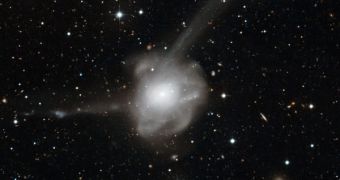Astronomers recently managed to snap an impressive photo of the galaxy NGC 7252, which is also known as Atoms-for-Peace. The view was taken by experts at the European Southern Observatory (ESO), using one of the organization's Chile-based telescopes.
In addition to looking really nice, this particular galaxy is also important in other ways. It represents what is known as a galactic merger, which is basically what happens when two galaxies collide against each other.
A complex series of interactions begins to take place, and the various components of the two cosmic structures start to intermingle. This creates areas of intense activity concentration, where gas and dust come together to form very dense nebulae.
With time, these regions become stellar nurseries, producing a myriad of young blue stars, which then go on to make the resulting galaxy more bright. The Atoms-for-Peace galaxy has been caught right in the middle of this process.
Astronomers say that studying it could give them added insight into how the Universe developed, as well as into the processes that shape galaxies. Our own Milky Way is the result of countless collisions with smaller, dwarf galaxies, and astronomers have yet to understand in full the intricacies of these interactions.
The object of the new study can be found approximately 220 million light-years away, in the direction of the constellation Aquarius. It appears as a small fuzzy blob to amateur astronomers, due to this immense distance.
But a couple hundred million light-years of distance pose no challenges to the Wide Field Imager (WFI) camera on the MPG/ESO 2.2-meter telescope, which is located at the La Silla Observatory, in Chile.
“A galaxy collision is one of the most important processes influencing how our Universe evolves, and studying them reveals important clues about galactic ancestry,” ESO experts say.
“Luckily, such collisions are long drawn-out events that last hundreds of millions of years, giving astronomers plenty of time to observe them,” they go on to add.
Studying galactic collisions will also help astronomers figure out what will happen three to four billion years from now, when the Milky Way will collide with the Andromeda galaxy, our closest neighbor.
Both are very large cosmic structures, and the merger is bound to produce one of the most impressive galaxies in the Universe. After that happens, the new formation will continue its present slip to the center of the Virgo supercluster, the main area of gravitational attraction in our corner of the Universe.

 14 DAY TRIAL //
14 DAY TRIAL //